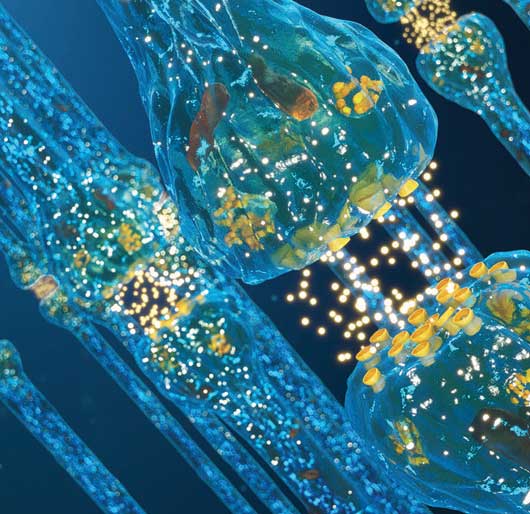 by Nitin Butala
by Nitin Butala
Dr. Butala is a Neurologist and Neurophysiologist at Baptist Health in Jacksonville, Florida and an Assistant professor of Neurology at the Lake Erie College of Osteopathic Medicine in Bradenton, Florida
FUNDING: No funding was provided.
DISCLOSURES: The author has no conflicts of interest relevant to the content of this article.
ABSTRACT: Background. Coronavirus infectious disease 2019 (COVID-19) has spread rapidly around the world and has been declared a pandemic by World Health Organization. Neurological manifestations are being reported in patients with COVID-19 but clinical guidelines and effective treatments remain unclear.
Objective. In this brief review, the authors examine the latest available evidence to date regarding the neurological implications of COVID-19 and how the novel coronavirus appears to impact patients with pre-existing neurological conditions. COVID-19-specific recommendations from the American Academy of Neurology and and other neurologic disease-specific organizations are summarized.
Results. Current retrospective case series and cohort studies from Wuhan, China, are indicating that almost one-third of the patients with COVID-19 have shown neurological manifestations; older age and comorbid conditions are associated worsened outcomes. Abnormal laboratory findings are being reported in acute cases of patients with COVID-19.
Summary. Understanding the spectrum of neurological manifestations of COVID-19 and the impact of COVID-19 on patients with underlying neurological conditions may help to improve outcomes.
KEYWORDS: Covid-19, coronavirus, neurological manifestations, neurology patients
Innov Clin Neurosci. 2020;17(4–6):13–15
Coronaviruses (CoVs) are large, enveloped nonpigmented positive-sense ribonucleic acid (RNA) viruses that typically manifest symptomatically in the gastrointestinal tracts and respiratory systems of mammals.1 A novel CoV—severe acute respiratory syndrome (SARS) coronavirus-2 (SARS-CoV-2)—was discovered in Wuhan, China, during a severe pneumonia outbreak that occurred on a national level. This novel virus, publicly labeled “coronavirus infectious disease-2019” or “COVID-19,” has spread quickly around the world, leading the World Health Organization (WHO) to declare it a global pandemic.2 Manifestations of the SARS-CoV-2 virus can vary from individual to individual, ranging from showing no symptoms at all to presenting with mild upper respiratory tract illness to presenting with severe pneumonia, respiratory failure, and ultimately death.3 More recently, scientists have noted neurological manifestations of this novel virus and are attempting to better understand its effects on the central nervous system (CNS) and the link between neurological complications and acute respiratory distress in infected individuals.1
Neurotropism of SARS-CoV-2
SARS-CoV-2 has a similar viral structure to other CoVs and shares a common pathway of infection.1 Previous strains of CoV showed evidence of neurotropism.4 SARS-CoV-2 enters the host cells via a cellular receptor angiotensin-converting enzyme 2 (ACE2), which is present in human airway epithelia, lung parenchyma, vascular endothelia, kidney cells, and small intestine cells.5 The brain also expresses ACE2 receptors over glial cells and neurons, making it a potential target for SARS-CoV-2.6 This virus has a 10- to 20-fold higher ACE2 binding affinity than other strains of SARS-CoV,6 and can travel through the host, reaching the CNS, via the circulatory system in early and late phases of the infection, as seen with past strains of SARS-CoV.7 This could be a potential basis for neuronal damage, an endothelial rupture in cerebral capillaries, and bleeding within the brain, resulting in death for some patients infected with COVID-19.6 Some researchers theorize that CoVs will first invade peripheral nerve terminals and then travel through the synapses to enter the CNS.4 Using experimental studies in transgenic mice, researchers reported involvement of neuroanatomic interconnections that caused dysfunction of the cardiorespiratory center in the brainstem, suggesting that infection in the CNS was strongly related to a higher mortality rates in patients with COVID-19.1 Multiorgan failure with widespread homeostatic dysregulation might be one cause for fatality in patients with COVID-19.6 However, predominant CNS involvement and subsequent brainstem damage-induced respiratory distress could also be a cause for fatality in these patients.1
Recent Data From Wuhan, China, Regarding Fatality Risk Factors in ACUTE Adult Patients with COVID-19
A retrospective, single-center case series from Wuhan, China, by Wang et al3 concluded that acute COVID-19 cases (in ICU) were significantly older in age (median age, 66 years) and had pre-existing comorbidities, including hypertension, diabetes, cardiovascular disease, and cerebrovascular disease. This suggests that pre-existing comorbidities increase the risk of worsened outcomes. Patients with the virus who were in ICU had number of laboratory abnormalities (depressed total lymphocytes, prolonged prothrombin time, and elevated lactate dehydrogenase), suggesting that cellular immune deficiency, coagulation activation, myocardial injury, hepatic injury, and kidney injury are all affected by SARS-CoV-2. These laboratory abnormalities are similar to those previously observed in patients with MERS-CoV and SARS-CoV infection.3
Another recent, retrospective cohort study from Wuhan, China, by Zhou8 et al reported higher mortality rates in patients with SARS-C0V-2 who were older in age, had D-dimer levels greater than 1g/mL, and had higher Sequential Organ Failure Assessment (SOFA) scores. Laboratory results from acute cases of SARS-C0V-2 showed elevated serum levels interleukin (IL)-6, high-sensitivity cardiac troponin I, and lactate dehydrogenase and lymphopenia.8
Recent Data From Wuhan, China, Regarding Neurological Symptoms in ACUTE Adult Patients with COVID-19
A recent retrospective analysis by Mao9 et al on hospitalized patients with COVID-19 reported almost one-third of the patients exhibited neurologic symptoms, which were classified as CNS symptoms or diseases (e.g., headache, dizziness, impaired consciousness, ataxia, acute cerebrovascular disease, epilepsy), peripheral nervous system (PNS) symptoms (e.g., hypogeusia, hyposmia, hypopsia, and neuralgia), and musculoskeletal symptoms. Patients with severe cases of COVID-19 had a higher rate of acute cerebrovascular diseases, consciousness impairment, and musculoskeletal symptoms compared to less severe cases. Headache and dizziness were the most common complaints in patients with CNS symptoms. Hypogeusia and hyposmia were the most common complaints in patients with PNS symptoms. The investigators also reported lower lymphocyte counts and higher D-dimer levels in patients with COVID-19 who exhibited neurologic symptoms.
Evolving Data
In a retrospective, observational case study by Li et al,10 investigators reported neurologic events in the form of acute ischemic stroke (5%), cerebral venous sinus thrombosis (0.5%), and cerebral hemorrhage (0.5%) in patients with COVID-19.10 Headaches, dizziness, and confusion were reported in other retrospective case studies from Wuhan, China.11-14 A few additional small case reports and series have reported Guillain-Barre Syndrome,15 hemorrhagic necrotizing encephalopathy,16 and seizures in acute cases of COVID-19.17
Are Patients with Underlying Neurological Conditions at Higher Risk of More Severe Complications Related to COVID-19?
Given the available data and observations, neurologists should be aware of the potential risk for more severe complications related to coronavirus in their patients. Patients with certain neurologic conditions are potentially at greater risk of becoming infected with COVID-19 developing more severe symptoms if they are older in age and have pre-existing comorbidities, such as diabetes, cardiovascular disease, lung disease, and weakened immune system.
Covid-19 Recommendations for Patients with Neurological Disorders
We reviewed neurologic disease-specific organization websites for COVID-19-related recommendations and provide the following summarized guidelines from these sites:
The National Medical Advisory Committee of the National MS Society has advised MS patients to continue their disease-modifying therapies (DMTs) and to not change or stop the treatments without discussing risks with their physicians.18
Muscular Dystrophy Association has urged the patients with neuromuscular disease to seek prompt medical attention if they are exposed to a person with COVID-19 that develop any symptoms consistent with COVID-19.19
American Parkinson Disease Association reports that there is no evidence that having Parkinson’s disease (PD) suppresses the immune system or increases susceptibility to being infected with the virus. However, someone with PD who contracts COVID-19 could experience an exacerbation of their motor and nonmotor symptoms.20
The Alzheimer’s Association, dementia does not increase the risk for contracting COVID-19; however, dementia-related behaviors, older age, and presence of pre-existing comorbidities might increase risk of experiencing more severe health-related complications due to COVID-19 illness.21
The Epilepsy Foundation advised that epilepsy alone does not increase the risk becoming infected with COVID-19 and does not increase the severity of COVID-19. They note, however, that having pre-existing comorbidities increases the risk for experiencing COVID-19-related health complications.22
The Guillain-Barre Syndrome (GBS)/ Chronic Inflammatory Demyelinating Polyneuropathy (CIDP) Foundation International advised that having GBS, CIDP or variants does not increase the risk of contracting COVID-19, but individuals who are treated with chronic immunosuppressive drugs (e.g., steroids, rituximab, cyclophosphamide, azathioprine) might have compromised immune systems with risk of increased susceptibility to any infection.23
American Migraine Foundation reports that people with migraine who are otherwise in good health are not at higher risk of getting infected with SARS-C0V-2 /COVID-19.24
American Academy of Neurology‘s journal, Neurology Today, provides the following recommendations: 1) Patients with minor illnesses should reschedule their appointments and consider opting for “telehealth visits;” 2) Reduced the number of people during an essential in-person visits; 3) Reschedule nonurgent visits and diagnostic testing and; 4) Physicians should disinfect their tools and equipment and use personal protective gear as appropriate.25
The United States (US) Centers for Disease Control and Prevention (CDC) recommends that everyone 1) avoid close contact with people who are sick; 2) avoid touching your eyes, nose, and mouth; 3) stay home when you are sick; 4) cover your cough or sneeze with a tissue, then throw the tissue in the trash; 5) clean and disinfect frequently touched objects and surfaces using a regular household cleaning spray or wipes; 6) use facemasks when out in public; and 7) wash your hands often with soap and water for at least 20 seconds.26
Clinical and Research Considerations
Information regarding COVID-19 is constantly evolving and new data are being released constantly. We have reviewed the most recent data available at the writing of the article (27 Apr 2020). To date, data are indicating an association between neurological symptoms and more severe COVID-19-related complications. Clinicians should be particular mindful of patients who present with neurological symptoms and should consider testing these patients for COVID-19. A better understanding of the potential neurotropic complications related to the SARS-CoV-2 virus will help us 1) create a staging system; 2) design treatment algorithms based on the severity of the disease and dominant organ involvement; and 3) triage patients for aggressive or conventional treatment modalities.1
There are currently no antiviral drugs approved by the US Food and Drug Administration (FDA) to treat COVID-19.26 A randomized, placebo-controlled, clinical trial of remdesivir for treatment of hospitalized patients with COVID-19-related respiratory disease has been implemented in China.26) A randomized, open-label trial of combination lopinavir-ritonavir treatment is also being conducted in patients with COVID-19 in China.26 The differences in the sequence of spike proteins between SARS-CoV-2 virus and SARS-CoV might enable scientists to develop monoclonal antibodies against this novel virus.1
References
- Li YC, Bai WZ, Hashikawa T. The neuroinvasive potential of SARS-CoV2 may play a role in the respiratory failure of COVID-19 patients. J Med Virol. 2020; 1–4 World Health Organization resources on COVID-19. https://www.who.int/health-topics/coronavirus. Accessed 22 Mar 2020.
- World Health Organization site. Coronavirus. https://www.who.int/health-topics/coronavirus. Accessed 22 Mar 2020.
- Wang D, Hu B, Hu C, et al. Clinical characteristics of 138 hospitalized patients with 2019 novel Coronavirus–infected Pneumonia in Wuhan, China. JAMA. 2020;323(11):1061–1069.
- Li YC, Bai WZ, Hirano N, et al. Coronavirus infection of rat dorsal root ganglia: ultrastructural characterization of viral replication, transfer, and the early response of satellite cells. Virus Res. 2012;163(2): 628–635.
- Hamming I, Timens W, Bulthuis ML, et al. Tissue distribution of ACE2 protein, the functional receptor for SARS Coronavirus. A first step in understanding SARS pathogenesis. J Pathol. 2004; 203(2): 631–637
- Baig A, Khaleeq A, Ali E, et al. Evidence of the COVID-19 Virus Targeting the CNS: Tissue Distribution, Host–Virus Interaction, and Proposed Neurotropic Mechanisms. ACS Chem Neurosci. 2020;11,7:995–998.
- Netland J, Meyerholz DK, Moore S, et al. Severe acute respiratory syndrome coronavirus infection causes neuronal death in the absence of encephalitis in mice transgenic for human ACE2. J. Virol. 2008:82(15):7264– 7275.
- Zhou F, Yu T, Du R, et al. Clinical course and risk factors for mortality of adult inpatients with COVID-19 in Wuhan, China: a retrospective cohort study. Lancet Elsevier. 2020;195(10229):1054- 1062.
- Mao L, Jin H, Wang M, et al. Neurologic Manifestations of Hospitalized Patients With Coronavirus Disease 2019 in Wuhan, China. JAMA Neurol. Published online 10 Apr 2020.
- Asadi-Pooya AA, Simani L. Central nervous system manifestations of COVID-19: A systematic review. J Neurol Sci. 2020 Apr 11;413:116832.
- Huang C, Wang Y, Li X, et al. Clinical features of patients infected with 2019 novel Coronavirus in Wuhan, China. Lancet. 2020;39510223: 497–506.
- Yang, X. Yu, Y, Xu, J,X. Yang, et al. Clinical course and outcomes of critically ill patients with SARS-CoV-2 pneumonia in Wuhan, China: a single-centered, retrospective, observational study. Lancet. 2020;8(5):475–481.
- Wang D. Hu B, Hu C, et al. Clinical characteristics of 138 hospitalized patients with 2019 novel coronavirus–infected pneumonia in Wuhan, China. JAMA. 2020;323(11):1061-1069.
- Chen N, Zhou M, Dong X, et al. Epidemiological and clinical characteristics of 99 cases of 2019 novel coronavirus pneumonia in Wuhan, China: a descriptive study. Lancet. 2020;395(10223): 507-551.
- Toscano G, Palmerini F, Ravaglia S, et al. Guillain-Barré Syndrome associated with SARS-CoV-2. N Engl J Med. NEJMc2009191. Online ahead of print.
- Poyiadji N, Shahin G, Noujaim D, et al. COVID- 19-associated acute hemorrhagic necrotizing encephalopathy: CT and MRI features. Radiology. 2020; Published online 31 Mar 2020.
- Karimi N, Sharifi Razavi A, Rouhani N. Frequent convulsive seizures in an adult patient with COVID-19: a case report. Iran Red Crescent Med J. 2020;22(3):e102828.
- National Multiple Sclerosis Society site. Coronavirus (Covid-19). https://www.nationalmssociety. org/coronavirus-covid-19-information. Accessed 18 Mar 2020.
- Muscular Dystrophy Association site. COVID-19 Resources. https://www.mda.org/covid19. Accessed 22 Mar 2020.
- American Parkinson Disease Association site. APDA COVID-19 Information and Resources. https://www.apdaparkinson.org/article/covid- 19-overview-for-pd-community. Accessed 22 March 2020.
- Caregivers. Alzheimer’s Association site. Coronavirus (COVID-19): Tips for Dementia.
https://www.alz.org/help-support/caregiving/ coronavirus-(covid-19)-tips-for-dementia-care. Accessed 22 Mar 2020. - Epilepsy Foundation site. COVID-19 and Epilepsy.
https://www.epilepsy.com/ article/2020/3/concerns-about-covid-19- coronavirus-and-epilepsy . Accessed 22 Mar 2020. - The GBS/CIDP Foundation International site. Coronavirus (COVID-19). https://www.gbs-cidp. org/covid19/. Accessed 22 Mar 2020.
- American Migraine Foundation site. 7 COVID-19 considerations for people living with migraine. 14 Mar 2020. https://americanmigrainefoundation.org/ resource-library/covid-19-migraine/. Accessed 22 Mar 2020.
- Fitzgerald, S. The Spread of COVID-19: questions raised, some answered by neuroinfectious disease expert. 2 Apr 2020. Neurology Today site. https://journals.lww. com/neurotodayonline/Fulltext/2020/04020/ The_Spread_of_COVID_19__ Questions_Raised,_Some.1.aspx?WT.mc_ id=HPxADx20100319xMP. Accessed 18 Mar 2020.
- Centers for Disease Control and Prevention site. CDC resources on COVID-19. https://www.cdc. gov/coronavirus/2019-ncov/index.html. Accessed 22 Mar 2020.





